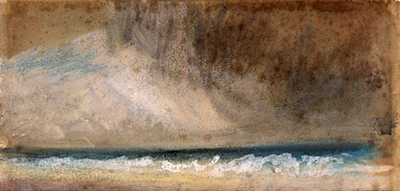This watercolour painting by William Turner is a brief study of a picturesque spot on the British seaside. It would have been one of a number of artworks produced within a single, bounded sketchbook.
The artist would travel around the UK and elsewhere in Europe, carrying these types of artist tools with him where ever he went. Whilst being a Romanticist artist and avoiding producing quite the same levels of detail as members of the Academic and Realism art movements, this particularly painting is brief even by his standards. It can be assumed to be a study piece, therefore. The simplicity of form can even be said to border on the abstract, even though such artistic styles did not really exist until the 20th century. Turner was someone who practiced his craft obsessively, and this attention to detail was essential to him reaching the levels of artistic technique that he did.
The dimensions of this watercolour painting immediately reveal its original position as part of a sketchbook. The pages are short and wide, far more than a standard landscape canvas on which he would produce oil paintings. The dimensions are also small, allowing these books to be carried around on his journeys. Several of his sketchbooks have actually been published in their entirety, with many finding it intriguing to look deeper into his methods of artistic development as well as understanding better just how he prepared for each major artwork. In recent years several British art institutions have attempted to acquire as many works as possible from his career, including lesser known pieces such as this.
The Tate Britain, Royal Academy and National Gallery hood a significant amount of his original work and are the best places to see some of the highlights of his breathtaking and extensive career. Curators are constantly challenging themselves to come up with innovative ways of displaying his work to the public, and have started to draw on a wider selection of his output in order to keep each presentation fresh and unique. This has ensured that drawings and watercolours have started to appear more frequently as the public chooses to delve deeper into his achievements. This study of a sky and sea would likely have provided the basis to a more detailed painting that followed on, probably with many other details added in, such as boats, figures and elements of architecture on the shore.




